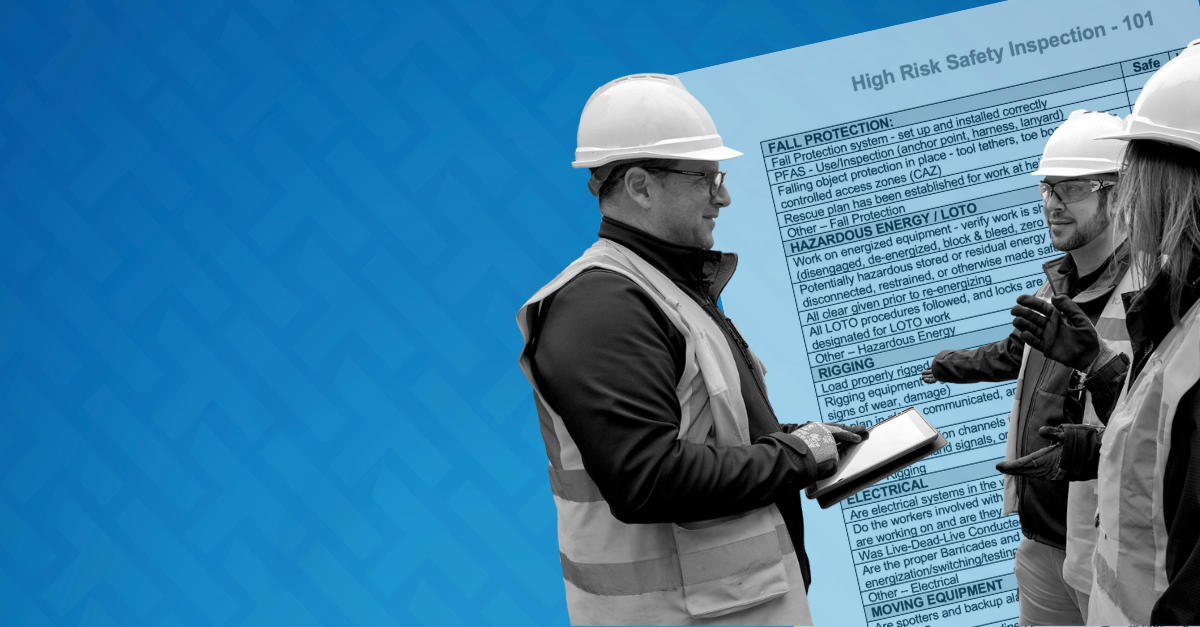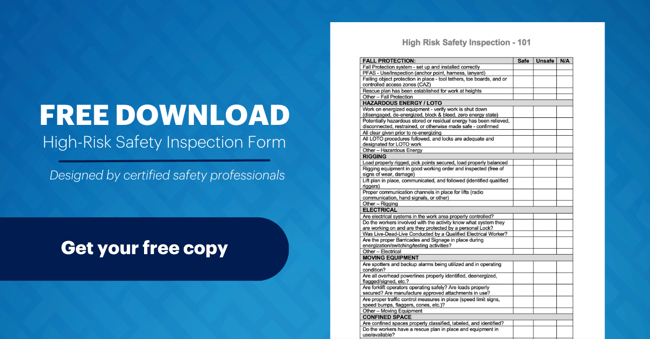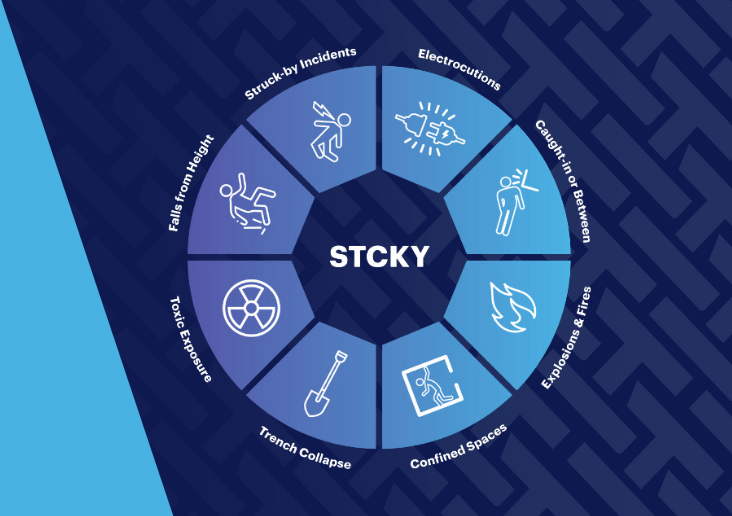High Risk Safety Inspections - Why Do They Matter?
General contractors face immense pressures to complete projects on time and within budget – compounded by material – and labor-related challenges.
And the truth is that investing in high-risk safety inspections, specifically targeting ‘STCKY’ (Stuff That Can Kill You) and ‘PSIF’ (Potential for Serious Injury or Fatality), is a savvy strategy for on-site safety and your bottom line.
This means a concerted focus on ‘high-risk safety inspections’ – to help identify and prevent the most dangerous hazards, which offers the best chance to avoid devastating incidents.
Spot the Difference: High-Risk Inspections & Regular Safety Inspections
In many industries, with advancements in safety regulations, total injury and illness rates have declined in recent years. However, rates of fatalities and serious injuries have not.
|
High-Risk Inspections |
Regular Safety Inspections |
|
|
Focus |
Specific to areas/tasks with higher potential for severe accidents or hazards |
General site-wide safety checks covering standard compliance |
|
Frequency |
Conducted as needed, generally before high-risk activities |
Scheduled periodically, typically weekly or monthly |
|
Scope |
Detailed and in-depth, targeting critical operations and high-risk conditions |
Broad and covers overall safety conditions and general site practices |
|
Personnel Involved |
May require individuals with specific expertise in high-risk areas |
Conducted by site safety officers or general safety personnel |
|
Examples of Inspection Areas |
Scaffoldings, heavy machinery, confined spaces, electrical systems |
Housekeeping, PPE compliance, general site maintenance |
|
Regulatory Requirements |
May involve more stringent and specific regulatory standards |
Follows general occupational safety and health regulations |
'PSIF' & 'STCKY' explained
A PSIF is an incident with the potential for serious injury or fatality. It seeks to identify not just severe incidents, but those that have the potential to be severe i.e. on-site hazards that can really hurt people without proper planning and precautions.
To learn more about the importance of PSIF, you can read this article: Why Contractors are Getting Proactive with PSIF.
‘Stuff That Can Kill You’, or STCKY, refers to the most dangerous on-site activities that – if not properly managed – can cause fatalities. Controlling STCKY hazards is crucial and involves implementing effective protections, controls, training and safeguards to ensure worker safety and prevent severe incidents.
“We need to do something about it”: Prioritizing High-Risk Safety Inspections
In the past, safety theories often missed serious on-site incidents. Take ‘Heinrich’s Triangle’ – a theory proposing less minor accidents means fewer serious ones. This approach misses up to 80% of serious on-site incidents, with such broad perspectives leading to poor outcomes.
Choosing to focus on STCKY or PSIF can help teams limit severe incidents like falls from height, electrocutions and toxic exposure, among others. This approach creates a fairer, safer, and more secure workplace, protecting workers from harm and reducing cost.
“In our U.S. construction industry, fatalities have increased and that's not acceptable,” said Reese Fortin, Director of HSE at Sundt Construction and Chairwoman of the AGC Safety Council in Arizona, at a recent HammerTech event.
“We need to do something about it,” adds Fortin, who founded Sundt's industry-recognized ‘Stop The STCKY’ campaign.
Rolled out across Sundt’s entire operations, ‘Stop The STCKY’ provides concrete evidence on how a proactive approach to managing high-risk situations on-site can benefit you.
.png?width=500&height=437&name=STCKY%20-%20Stuff%20That%20Can%20Kill%20You%20-%20Construction%20Safety%20chart%20(NO%20HammerTech%20Logo).png)
The Cost of Ignoring High-Risk Activities
The total cost of workplace injuries and fatalities is estimated to be up to $151 billion per year, according to the National Safety Council, America’s leading nonprofit safety advocate. The construction industry accounts for a large portion of this, with STCKY and PSIF costing companies like yours the most.
Studies show that when companies allocate just 2.5% of project costs to targeting high-risk areas, accident rates fall and profits rise by 4-7% per project.
Focusing on high-risk activities is one of the best decisions you can make. In short, implementing comprehensive safety programs – with regular inspections, thorough training on high-risk activities and meticulous project planning – is a smart strategy that will pay off.
High-Risk Safety Inspections: A How-To Guide
You’re ready to embrace high risk safety inspections and make our project safer place to work.
But where to start?
1. Focus on High-Risk Activities First
High-risk tasks and activities with a significant potential for serious injuries or fatalities are an ideal place to start.
-
-
-
Crane Operations: Risk of catastrophic accidents involving heavy lifting and overhead loads
-
Confined Space Entry: Risk of suffocation, toxic exposure or entrapment
-
Working at Heights: Risk of falls, the leading cause of fatalities in construction
-
Electrical Work: High risk of electrocution or burns
-
Excavation and Trenching: potential for cave-ins and engulfment
-
Struck-by Incidents: Risk due to moving equipment and falling objects
-
Explosions & Fires: Risks from flammable materials and hot work
-
Toxic Exposure: Risks from hazardous substances and materials
-
-
2. Key Dependencies
Training: All personnel should be trained in hazard identification, proper use of safety equipment, and correct procedures for reporting and mitigating risks.
Detailed Records: Recording identified hazards, actions taken to mitigate them, and follow-up actions helps track safety performance over time and provides valuable data for improving practices.
Clear Communication: Inspectors must communicate their findings to the site workers clearly and promptly. This can also feed back into training programs.
3. Focus on Immediate risks that affect worker safety
While all OHSA standards are important, focus on what poses immediate risks to workers to prevent serious incidents.
Implement a regular schedule of inspections with different focuses:
-
-
-
Daily inspections should cover key safety items
-
Weekly and quarterly inspections should address a broader range of potential hazards
-
-
This layered approach means high-risk areas are consistently monitored, and emerging risks are identified and quickly corrected.
4. Use tech to Simplify High-Risk Inspections

Digital tools and platforms like HammerTech make high-risk inspections much easier and more effective. They go above and beyond basic requirements:
-
Real-Time Data Collection: Get immediate access to critical information without manual data entry hassles.
-
Instant Alerts and Notifications: Take immediate action on identified hazards.
-
Integrated Documentation: Easily attach photos, notes, and corrective actions all in one place.
-
Inspection Quality: Ensure the right spread of hazards are being inspected with documented positive and negative observations, including proper issue close-out.
Example
If an inspection shows that several workers aren’t wearing gloves, a simple corrective action could be the provision of better-fitting gloves. This keeps workers safer, reduces incidents and associated costs, and allows work to proceed more efficiently.
Let’s continue to build safer, smarter, better — together.
Get involved and join the many companies implementing a program focused on high-risk today.
To begin building your high-risk safety inspection program – download the free template for "High-Risk Safety Inspections".






